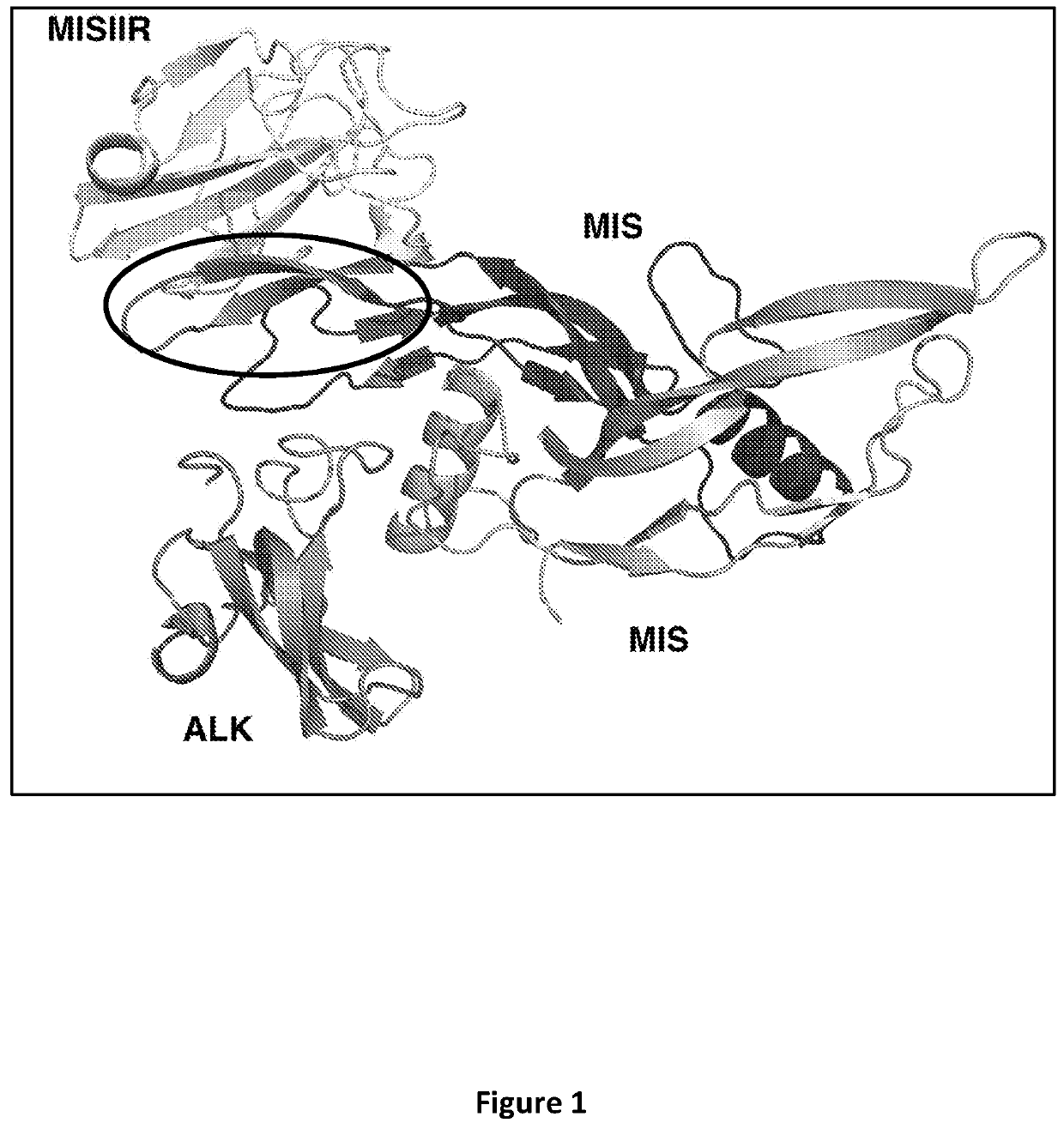Chimera of bone morphogenic protein 2 and the Müllerian-inhibiting substance type II receptor binding region of Müllerian-inhibiting substance
a chimera and bone morphogenic protein technology, applied in the field of cancer therapy, can solve the problems of difficult molecule to express in quantity in cell culture, industry groups to produce native mis in quantities, and antibody-based strategies unlikely to succeed
- Summary
- Abstract
- Description
- Claims
- Application Information
AI Technical Summary
Problems solved by technology
Method used
Image
Examples
example 1
BMP2-MIS Chimera Molecule
[0061]The chimera molecule is based upon the hormone bone morphogenetic protein 2 (BMP2). Like MIS, BMP2 belongs to the TGF-β superfamily, and it binds to the same Type I receptors—activin receptor-like kinase (ALK) as MIS, although it binds to a different Type II receptor (activin type II receptor, ACVR2). BMP2 is a material capable of being used for bone mending. The natural affinity of BMP2 for ALK has been used to design several synthetic hormones, each resembling BMP2 but with the Type II binding region replaced by that of MIS. Without intending to be limited to any particular theory or mechanism of action, it is believed that the resulting chimera molecules will activate signaling through MISIIR / ALK, leading to apoptosis of the target cell.
example 2
Identification of Key MIS Loop
[0062]The three-dimensional structures of MIS and MISIIR have not been solved by X-ray crystallography. Accordingly, a homology model was created using closely related known structures. A crystal structure of the ternary complex of BMP2 bound to ACVR2 and BMP1R, was employed. Based on this modeling, it was determined that the binding between MIS and MISIIR is mediated by an 18-residue loop on MIS (FIG. 1). With this insight, experiments were conducted to impart specificity for MISIIR to an irrelevant scaffold to demonstrate the importance of this loop.
[0063]A non-specific antibody with a compatible variable domain framework was selected, and the loop was grafted in place of the heavy chain complementarity determining region (CDR) 3 (WO / 2012 / 166712). The ability of this MIS-loop grafted antibody to compete with native MIS for MISIIR was then tested in a competitive binding assay. The modified antibody was allowed to compete with MIS for binding to P19 ne...
example 3
Redesign of BMP2
[0064]A goal is to develop a molecule that mimics the ability of MIS to signal for apoptosis by binding to MISIIR and ALK. Since BMP2 naturally binds to ALK, it was hypothesized that a similar approach to that described above to create the loop-grafted antibody could be used to change the type II receptor specificity of BMP2 from ACVR2 to MISIIR without affecting the ALK binding region.
[0065]Computational methods were used to determine the optimal location for the MIS loop graft within the BMP2 framework along with additional framework changes that were necessary to accommodate and properly orient the key MIS loop. Using modeling software, multiple designs were created in silico, corresponding to chimeric models comprising different regions of MIS and BMP2. Designs were selected using a scoring algorithm that prioritized designs based upon total energy. Total energy of chimera homodimers and the complex of the chimera homodimer with a model of MISIIR and ALK2 target ...
PUM
| Property | Measurement | Unit |
|---|---|---|
| time | aaaaa | aaaaa |
| concentrations | aaaaa | aaaaa |
| concentrations | aaaaa | aaaaa |
Abstract
Description
Claims
Application Information
 Login to View More
Login to View More - R&D
- Intellectual Property
- Life Sciences
- Materials
- Tech Scout
- Unparalleled Data Quality
- Higher Quality Content
- 60% Fewer Hallucinations
Browse by: Latest US Patents, China's latest patents, Technical Efficacy Thesaurus, Application Domain, Technology Topic, Popular Technical Reports.
© 2025 PatSnap. All rights reserved.Legal|Privacy policy|Modern Slavery Act Transparency Statement|Sitemap|About US| Contact US: help@patsnap.com



